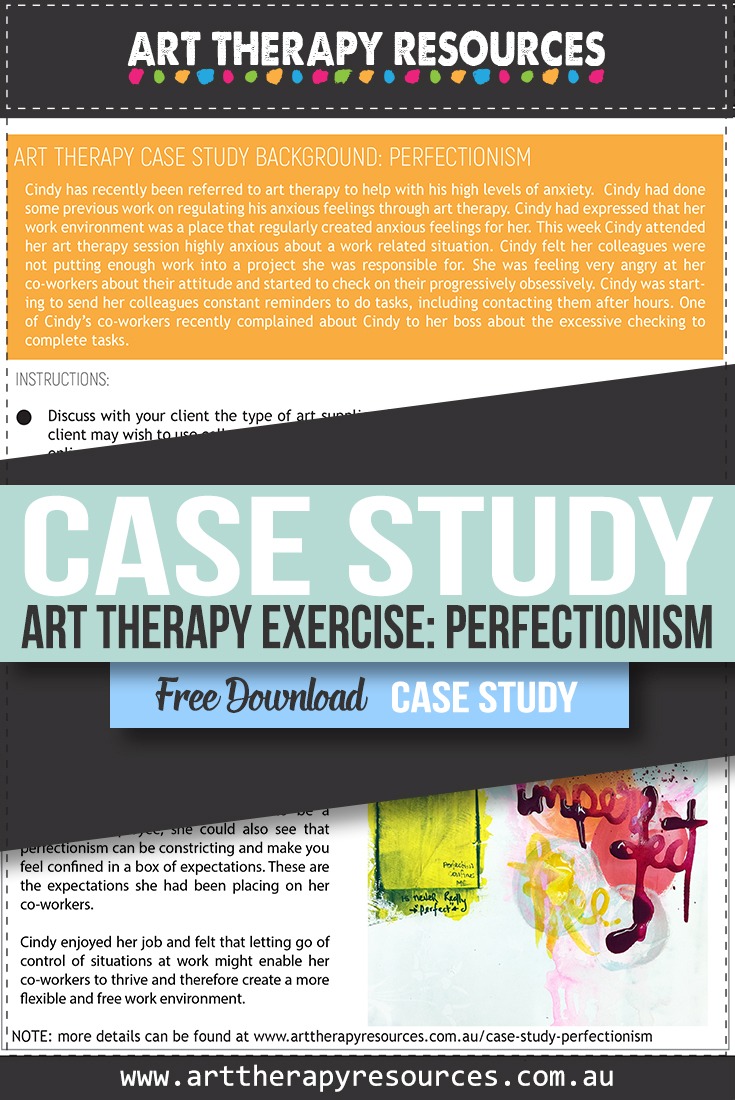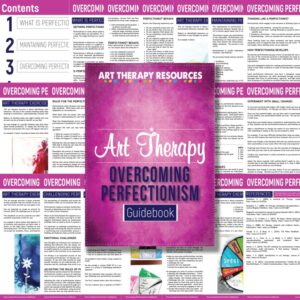THIS POST INCLUDES:
- Art Therapy and Perfectionism
- About the Client
- Current Client Issues
- Art Therapy Exercise
- Client Insight and Outcomes
- Disclaimer
- FREE DOWNLOAD Art Therapy Exercise
ART THERAPY AND PERFECTIONISM
Perfectionism is rarely about achieving a known standard of being perfect. Instead, perfectionism is usually about our perception. It’s about pursuing high standards that we have formulated in our minds. You might find that two “perfectionists” hold completely different standards of what perfect is.
Perfectionism is about how we judge our self-worth and those around us. Unfortunately, the pursuit of perfectionism usually results in a negative mindset vs a positive mindset. Therefore, it stands to reason that when we set the standards of perfect so high that we rarely achieve it, then we will rarely get to experience the satisfaction of achieving it.
IS PERFECTIONISM POSSIBLE?
Perfectionism is often seen as a positive state to pursue because the connotation is that we are working towards excellence. Perfectionism is tied to efficiency, organisation, and highly developed skills. Ironically though, the high standards we attach to perfectionism can sometimes get in our way as we expend more energy on the pursuit of an imagined standard instead of actually progressing in our desired goal.
Perfectionism is also self-defeating because as soon as we reach our ideal standard of perfectionism, we begin to raise the bar to achieve an even higher level of perfection. The expectations we place on ourselves rarely provides us with an opportunity to appreciate our hard work and achievements.
This means we are constantly faced with failure or the potential threat of failure and as a result, we are constantly criticizing ourselves about our thoughts and behaviours. This constant criticism can often lead to frustration, anger, worry, disgust, and a persistent sense of low self-worth.
In some areas of our life, we feel content with our standards, however, in other areas we feel that we are failing our own standards. Being a perfectionist can sometimes mean we apply high standards to all areas of our life or sometimes only one or a few areas in our life.
PERFECTIONIST BEHAVIOURS:
Some common behaviours that indicate a perfectionist mindset include:
- Avoidance – avoiding a situation for fear of failure
- Procrastinating – delaying a situation for fear of failure
- Giving up – leaving a situation for fear of failure
- Approval seeking – constantly seeking approval that your efforts are acceptable
- Excessive organising – can make you feel you are being attentive to the goal
- Checking – repeatedly checking the outcomes of something you are focused on. Examples include – work you’ve done, your weight, if someone has read your message
- Hoarding – keeping belongings for an excessively long time ‘just in case’
- Anger – at a situation, person, or yourself for not meeting a standard of ‘perfect’
Beyond these behaviours there can be significant detriment including depression, relationship breakdowns, insomnia, eating disorders, and general poor health.
ACHIEVING A BALANCE
The pursuit of high standards can help us achieve goals and challenge our personal growth. In many cases, it can actually save lives if you think of the consequences of training a brain surgeon.
However, it’s important to remember that life is imperfect and so are we.
If you’re interested in obtaining additional resources on the topic of Perfectionism, you may be interested in our guidebook in the store:
Art Therapy Guidebook – Overcoming Perfectionism
This guidebook provides you with a foundational understanding of perfectionism including what is perfectionism, how it is maintained, and a pathway to overcoming perfectionism.
MAIN TOPICS INCLUDE:
- What is perfectionism
- Maintaining perfectionism
- Overcoming perfectionism
- Challenging perfectionism
- Redefining perfectionism
- Art therapy exercises
- Guidebook references
ABOUT THE CLIENT
- Name: Cindy
- Gender: Female
- Age: 38
- Summary of sessions to date: Cindy has recently been referred to art therapy to help with his high levels of anxiety. Cindy had done some previous work on regulating his anxious feelings through art therapy. Cindy had expressed that her work environment was a place that regularly created anxious feelings for her.
CURRENT CLIENT ISSUES
This week Cindy attended her art therapy session highly anxious about a work related situation. Cindy felt her colleagues were not putting enough work into a project she was responsible for. She was feeling very angry at her co-workers about their attitude and started to check on their progressively obsessively.
Cindy was starting to send her colleagues constant reminders to do tasks, including contacting them after hours. One of Cindy’s co-workers recently complained about Cindy to her boss about the excessive checking to complete tasks.
ART THERAPY EXERCISE
This art therapy exercise can help identify perfectionist behaviours. After some psychoeducation on the common behaviours that indicate a perfectionist mindset, the client can reflect on whether they can identify any perfectionist traits in their own behaviour.
INSTRUCTIONS:
- Discuss with your client the type of art supplies they may like to work with in this session. Your client may wish to use collage techniques and collect images from magazines or free clip art from online sources (eg. http://www.freepik.com/). Alternatively your client can use drawing or painting materials.
- Ask your client to reflect on the common perfectionist behaviours and reflect on whether they can identify any of those behaviours in a current situation that is causing them stress.
- Ask your client to create an artwork based on this reflection or their thoughts on perfectionism in general.
- After your client has completed the art therapy exercise, you can discuss their choices of images and words and whether they could identify any specific perfectionist behaviours that they exhibit.
CLIENT INSIGHT AND OUTCOMES
Cindy reflected on perfectionism and how she can identify traits of perfectionist behaviours through her current work situation. She noted that while pursuing perfectionism appeared to be based on a desire to be a competent employee, she could also see that perfectionism can be constricting and make you feel confined in a box of expectations. These are the expectations she had been placing on her co-workers.
Cindy enjoyed her job and felt that letting go of control of situations at work might enable her co-workers to thrive and therefore create a more flexible and free work environment.

DISCLAIMER
This case study represents a snapshot of the client’s progress in treatment. The exercise in this article could be used as written or as a guide for new and original tasks developed by the Art Therapist. Responsibility for treatment resides with the individual therapist who understands their clients specific needs. The art therapy exercise should not be viewed as a pre-defined directive on how to treat a client that presents with a specific range of problems.This art therapy exercise will help build a database of knowledge to draw upon when helping your client. Art Therapy is associated with psychotherapy techniques, however each therapist often approaches therapy with their own foundation of psychological interventions, whether it be psychotherapy, CBT, DBT or other methods.
FREE DOWNLOAD: Art Therapy Exercise
Download the FREE Art Therapy Exercise based on the above Case Study. The free download includes instructions for the art therapy exercise, along with an example of the art therapy exercise.

BUILD YOUR ART THERAPY REFERENCE MATERIALS:
Pin this image to your Pinterest board.

SHARE KNOWLEDGE & PASS IT ON:
If you’ve enjoyed this post, please share it on Facebook, Twitter, Pinterest. Thank you!

